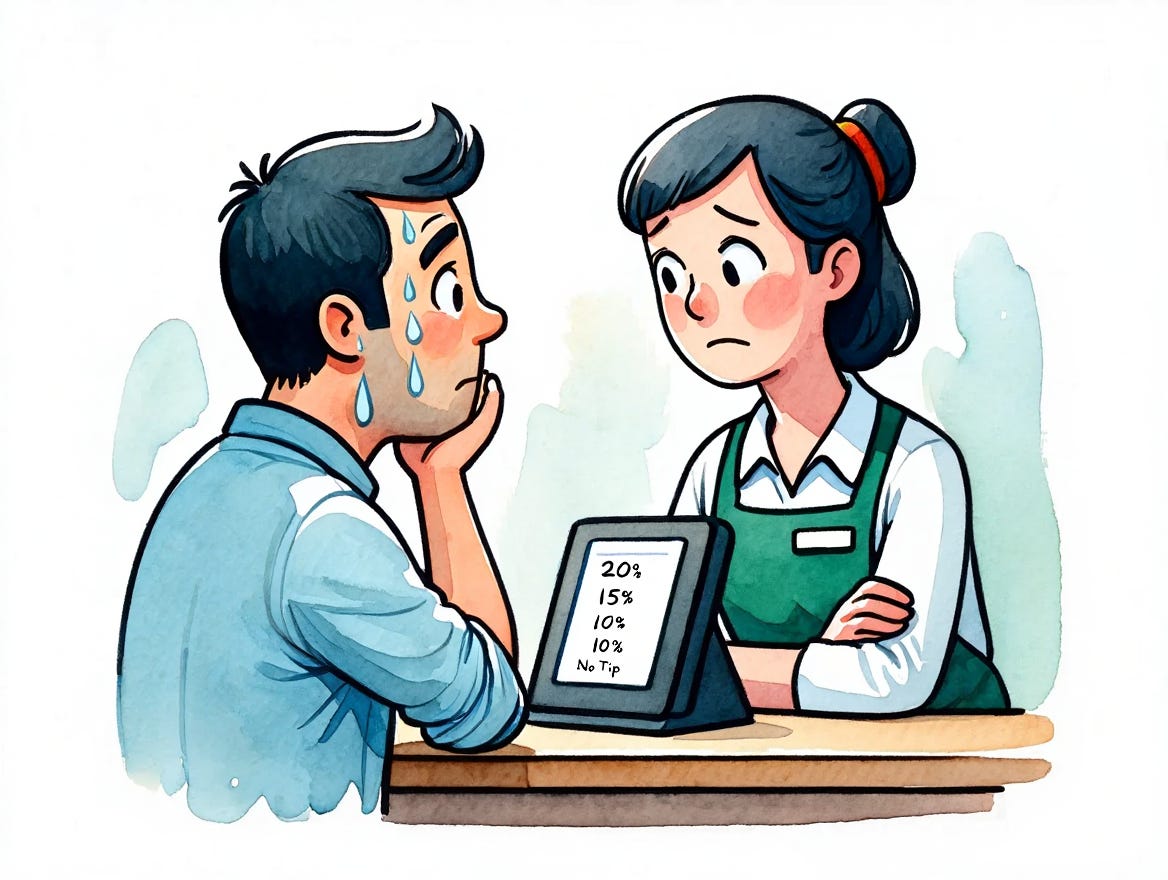Baristas, Tips, and the $13 Wage Trap
The Hidden Economics of Coffee Shop Tipping
👋 Welcome to Hidden Economics — real-world strategies to win at everyday money.
Each week, we decode the hidden forces behind what you spend, save, and lose — often without even realizing it.
How Tipping Culture Got Here
It used to be that tipping was reserved for waiters, taxi drivers, and maybe a hotel bellhop—people who offered personalized service over time. But over the last decade, especially since the rise of digital checkout screens, tipping has quietly expanded into coffee shops, bakeries, fast-casual takeout, airport counters, and even retail stores.
You're not imagining it—the rules really did change.
💡 Hidden Insight: Tipping culture has expanded not because service changed, but because technology changed the moment of payment—allowing businesses to outsource wage pressure to customers.
That’s part of why so many people feel caught off guard, even annoyed, when asked to tip for a $4 bagel or a to-go salad. It’s not just about money—it’s about confusion around what tipping even means anymore.
Why $13 an Hour Isn’t Enough
The average hourly wage for a barista in the U.S. is about $13/hour. That may sound decent—especially compared to minimum wage—but let’s break it down:
At 35 hours a week, that’s $1,820 per month before taxes
Subtract taxes, and you’re left with maybe $1,500 take-home
In many cities, rent for a basic studio apartment is $1,000 or more
That leaves just $500/month for everything else—food, transport, phone, insurance, student loans…
This is what we mean by the $13 Wage Trap: A wage that sounds livable on paper, but collapses under the cost of real life, especially in urban areas.
And that’s where tips come in.
Tips often add another $5 to $9 per hour, depending on location and traffic. For some baristas, tips account for 30%–40% of their total income—making the difference between covering rent or not.
Without tips, many baristas simply couldn’t afford to stay in the job.
💡 Hidden Insight: When a barista earns $13/hour, they often spend more than half their income on rent. That $1 tip you add? It’s part of their survival strategy.
Where Your Tip Actually Goes
Contrary to what many people assume, tipping at a coffee shop doesn’t work the same way as it does at a sit-down restaurant.
In most independent coffee shops and counter-service spots, tips are pooled—shared among all the baristas and counter staff who worked that shift (or that week).
At major chains like Starbucks, tips are also pooled, though usually just among baristas and shift supervisors—not managers or owners.
At some smaller shops, owners may take a share (or even all) of the tips—especially if wages are higher or business is tight.
So even if the person at the register didn’t seem especially friendly, your tip may still help support the entire crew making drinks, cleaning up, prepping food, and restocking supplies behind the scenes.
In short: your tip might not go to the one person who served you—but it is likely to help a team of low-wage workers trying to make ends meet.
💡 Hidden Insight: Even if you didn't receive amazing service, your tip helps support everyone behind the counter—not just the person ringing you up.
The Psychology of the Prompt
Digital tipping screens aren’t neutral.
They're designed to nudge you.
Default options like 15%, 20%, and 25% make “No Tip” feel like the wrong choice.
Sometimes the “No Tip” or “Custom” button is hard to find or requires extra effort.
You’re often being watched—or think you are—when making that decision.
But here's the truth: you're not required to tip. Tipping is voluntary. And if the service was rude or dismissive, it’s perfectly okay not to leave one.
That said, understanding the economics behind the tip jar might lead you to think differently.
Maybe the person who rang you up wasn’t especially charming. But your tip might help the 19-year-old college student on espresso, or the exhausted mom on food prep, or the guy mopping floors before his second job.
You don’t owe anyone a tip. But sometimes, being generous just feels good—especially when you know the whole story.
🧭 Coming next: The Hidden Economics of Trump’s New Tariffs — and how they might raise your grocery bill more than your taxes.
Enjoyed this breakdown? Subscribe to Hidden Economics for real-world strategies to win at everyday money — delivered weekly. No spam. No noise. Just practical, helpful insights that make you smarter with money.
👉 Subscribe now or share this post with someone who tips but isn’t sure why.


